Given the technical nature of the texts, manuals are not always easy to translate quickly. Apart from the content, you also need to worry about reproducing the translation in the original layout and design.
You're sending documents back and forth, cross-referencing, as well as copy-pasting translations into text boxes. When most of your time is spent doing tedious manual work, even a short document can take weeks to translate.
So what is the best way to achieve accurate translations for manuals or user guides? How can you ensure that your manual translations are accurate and consistent in both design and terminology use without spending too much time?
You'll find the answer to all your questions in this complete guide on manual translation.
Overview
- Translating Manuals: Common Problems
- How to Translate Manuals with Redokun: A 4-Step Guide
- Why Translate Manuals with Redokun
- Can You Still Outsource Your Translations with Redokun?
- Manual Translation: Best Practices
- FAQs
- Summary
Translating Manuals: Common Problems

You might find it challenging to get your product manuals to market, whether your team creates them in InDesign, Document360, Word, or other software. Here are some common factors that can make manual translation challenging:
a) Overwhelming amounts of manual work
Regardless of what type of software you use to create manuals, translating them often entails a huge volume of manual tasks. Imagine having to copy-paste translatable text from the original manual file to a separate document, send those to translators, and continually review and leave comments… It already sounds exhausting.
Now multiply it by the number of languages you need to localize your manual! And once the translations are ready, you need to copy-paste the content to the original file - again. This is simply an ineffective use of your time.
b) Keeping technical terminology consistent and accurate
Manuals typically contain industry-specific terminology and technological jargon that can be difficult to translate. And even a single mistake can lead to serious problems for your business.
Imagine you’re translating a highly detailed manual for heavy industrial machinery operation. A poorly translated product manual can result not only in an improper use of the machine—but also in accidents involving possible injuries.
That’s why quality manual translation ensures that key terminology is consistent across different language versions. Such consistency is tough to achieve if you turn to different translation vendors to handle different language pairs. The lack of communication between translators from several agencies can lead to disparity in terminology translation.
c) High translation costs
Manual translation is often more expensive than other documents—mainly due to the technical nature of the content. But that’s not the only possible source of added translation costs.
If you outsource manual translation to translation vendors, you effectively lose control over the translation process. You risk late translation delivery, you can’t make sure multi-language translations are consistent, and you don’t get to reuse previous translations. All these problems can drain your project budget.
As Pawel Borsuk mentions:
d) Coordinating the translation process of manual translation into multiple languages
You would usually need to translate your manuals into more than one language - and that’s when things can get tricky for your team. Managing the translation process to 15+ languages is nothing short of a challenge. You need to coordinate linguists, numerous documents and files, and track the translation progress for each language pair.
If you do it manually, you’ll find the process extremely time-consuming and confusing. Often you cannot even trace down which professional is responsible for which task.
Yes, this list of pain points looks like a handful, but they can all be solved easily with a translation management system like Redokun.
Using Redokun, your team can get started translating user manuals in minutes. But what’s better is, you can reduce the time you would spend checking the status of tasks, reusing past translations, and recreating designs to the click of a button.
Translating a manual in Redokun will take you four simple steps.
How to Translate Manuals with Redokun: A 4-Step Guide

Translating manuals, especially technical manual translation, can be a complex task that requires precision and attention to detail.
Step 1: Upload your manual on Redokun
- To upload documents on Redokun, create your free account first. You can start a 14-day trial right away (no credit card details required).
- Once your account is up and running, go to Document Upload and upload your technical manual to the Redokun Web Editor.
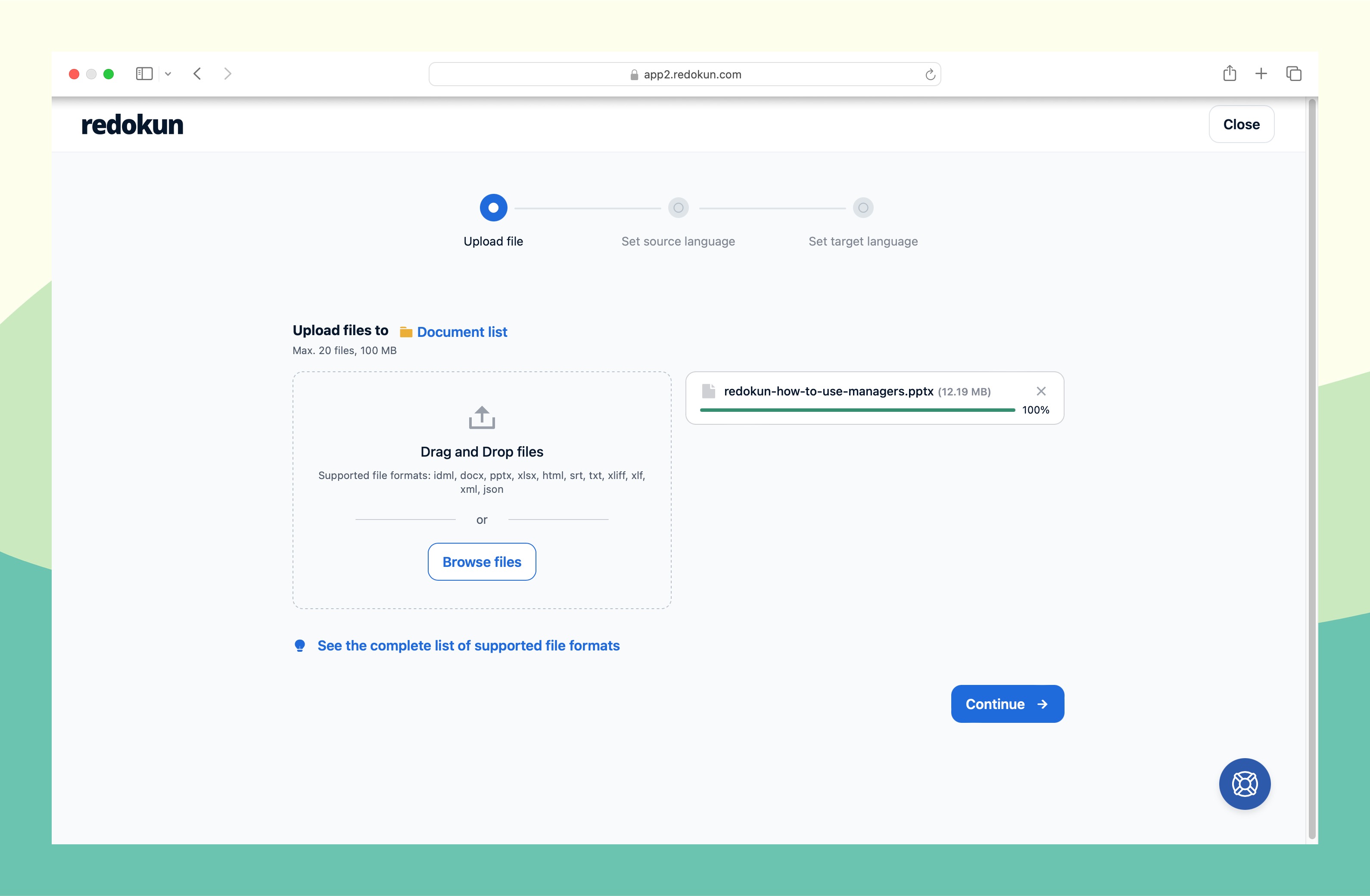
- Redokun allows you to translate manuals created in various types of software, including InDesign, FrameMaker, Word, Document360, etc. If the file you want to translate is not directly supported by Redokun, you can export it into XLIFF or HTML to proceed with the translation.
This guide shows you how to translate a manual created in InDesign. If you want to learn more about InDesign file translation, download our comprehensive InDesign Translation E-book.
- Once your manual is uploaded, choose the source language and select the target languages. You can check all the available languages in the Language Settings.
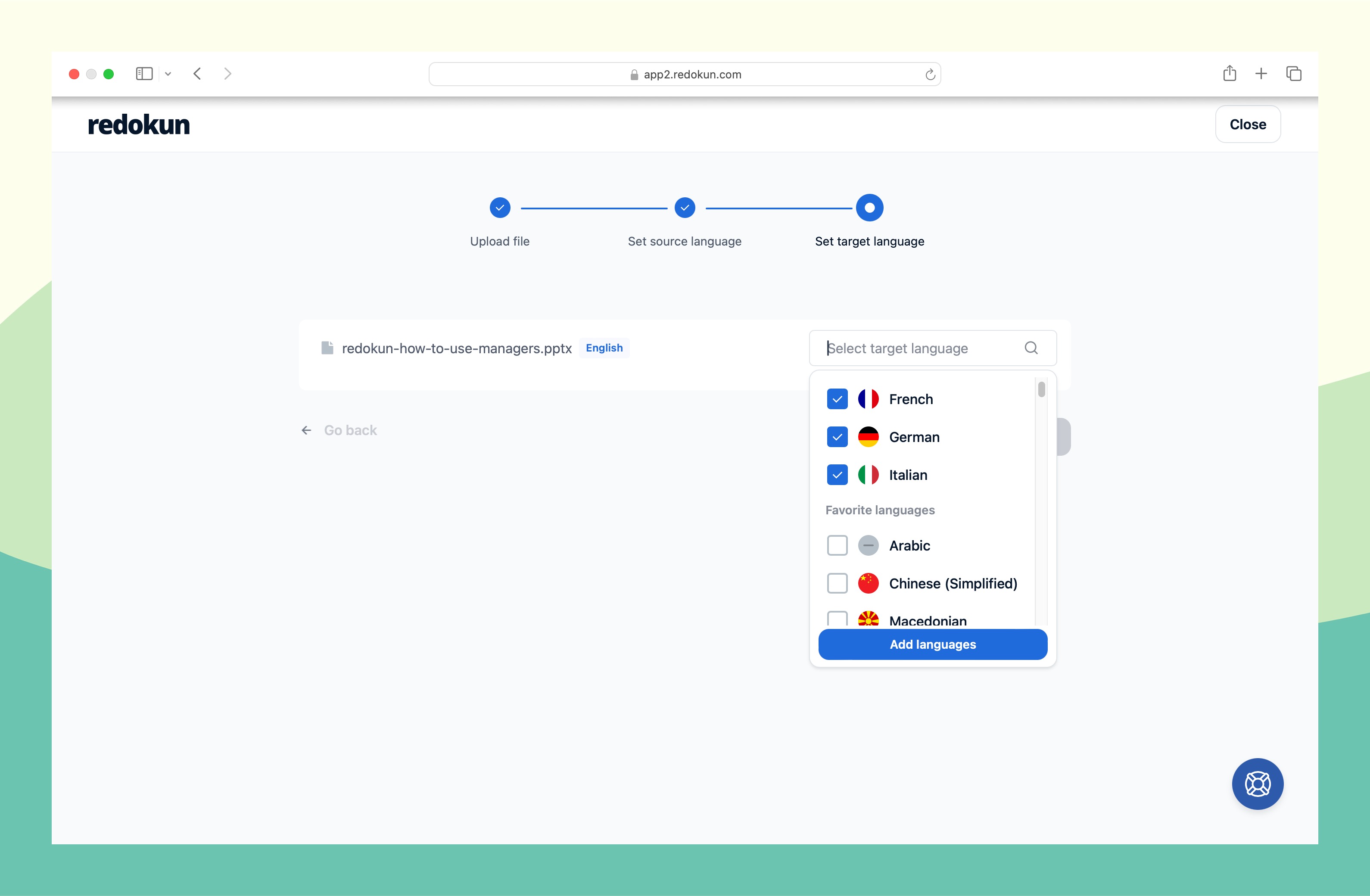
Redokun supports 88 different languages, including local language variations (e.g. British vs. American English).
Step 2: Invite language experts to translate the manual
- Choose the translators you want to involve in your manual translation project.
- Invite them to the Redokun Web Editor. All you need to do is enter their email in the Pick a Translator field. They will instantly receive the notification in their inbox.
- You can assign a different translator to each language pair ensuring you get the best technical manual translation services.
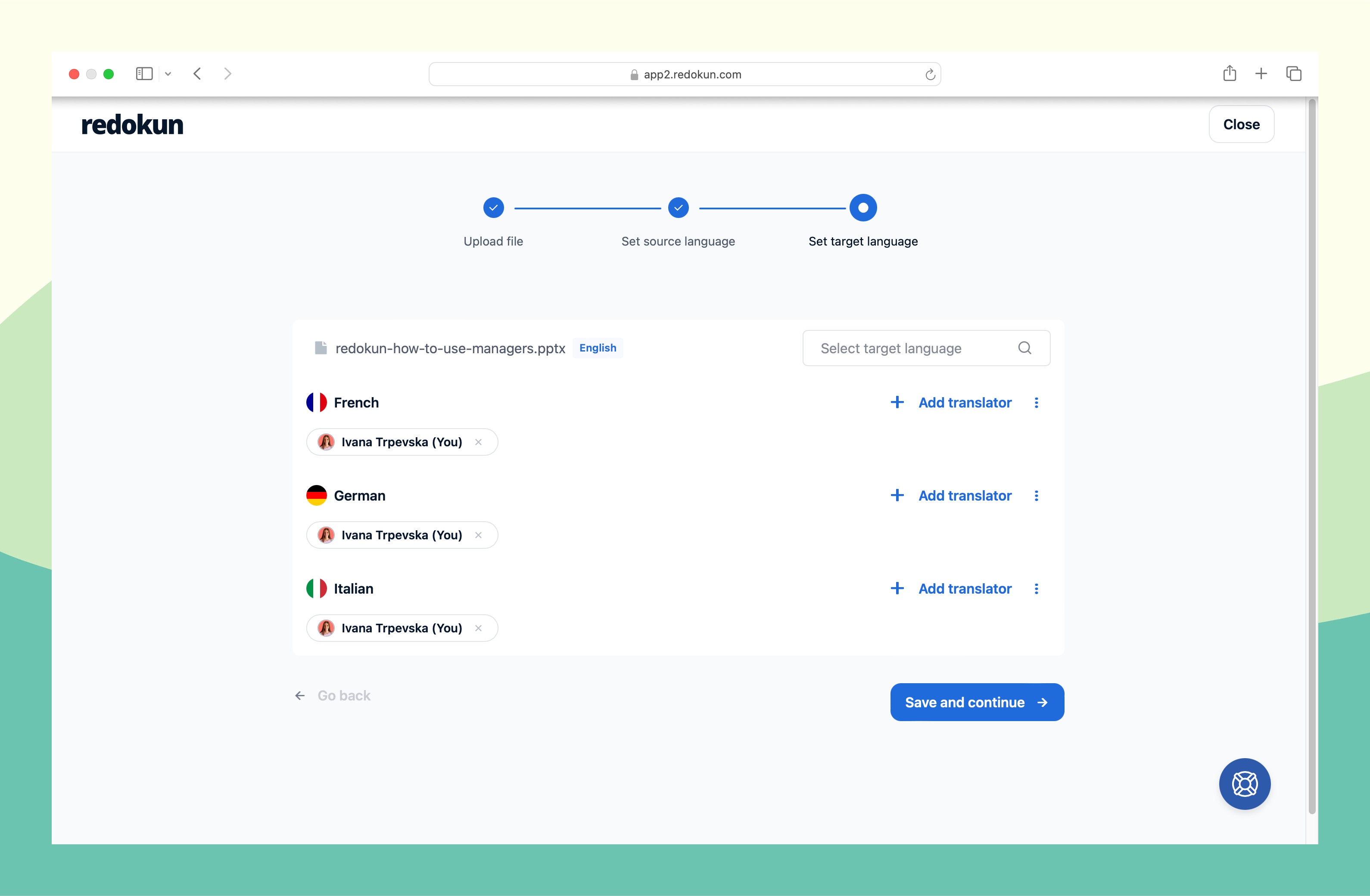
Optional Step. Pre-Translate the Entire Manual
Before inviting translators to translate your manual, you can take advantage of our Pre-Translate feature to efficiently translate technical manuals.
Prefer to watch a video instead? Here's how the pre-translate feature works in Redokun:
Redokun uses Translation Memories to offer accurate translation suggestions for identical source segments based on your previously translated documents. In other words, it detects segments that are similar to the content you’ve already translated and automatically fills in the relevant portions of text with the past translations.
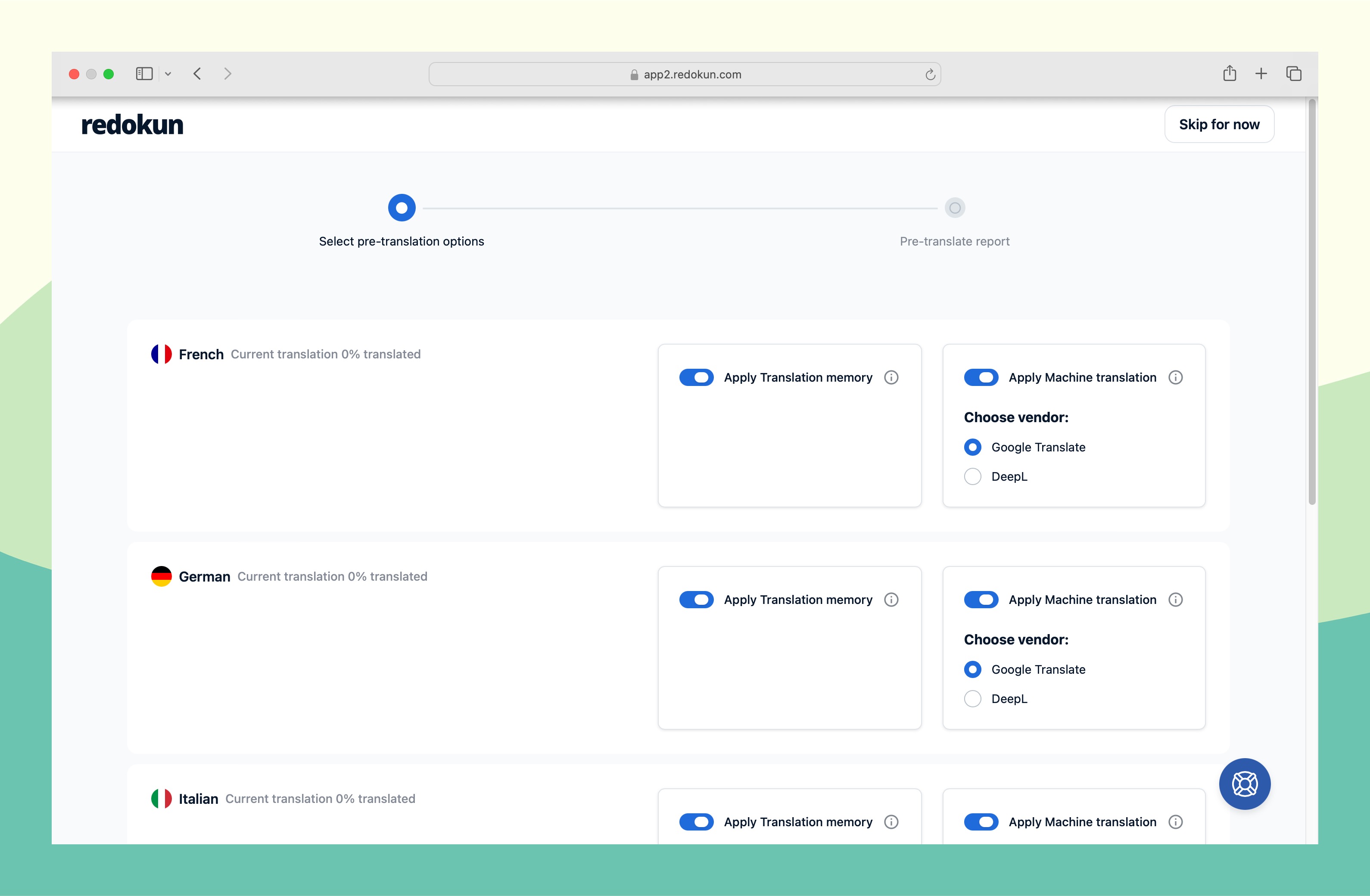
As you translate more documents with Redokun, each of your following translation projects will require less workload. Translation Memory will accumulate a unique glossary for your projects. You’ll never have to translate the same word twice.
Step 3: Translate the manual on Redokun Web Editor
Now, your translation team can start working on translating technical manuals.
- The Redokun Web Editor interface is simple and intuitive. It facilitates an efficient translation workflow and helps translators as they work.
- The text of the manual is automatically segmented into small portions to simplify translation.
- Take advantage of Machine Translation tools integrated into Web Editor for a more exact and fact-paced translation process. You can get segment translation suggestions from Google Translate and DeepL.

Use the comment section in the Editor to leave instructions, add comments, and communicate with your project team members. You can also comment on specific content segments by clicking on Add Comment next to each translation segment.
Step 4: Download the translated manual with the original design intact
- When your team has translated the manual, confirm and lock the translation. It will make the file non-editable for anyone except the owner of the file. This way, you can make sure no one can make unnecessary changes to the translated file.
- Once you’ve confirmed the translation, click on the green Download icon in the top right corner of the document page.
- Redokun will automatically generate the file in the same format as the original. It preserves all the design features.
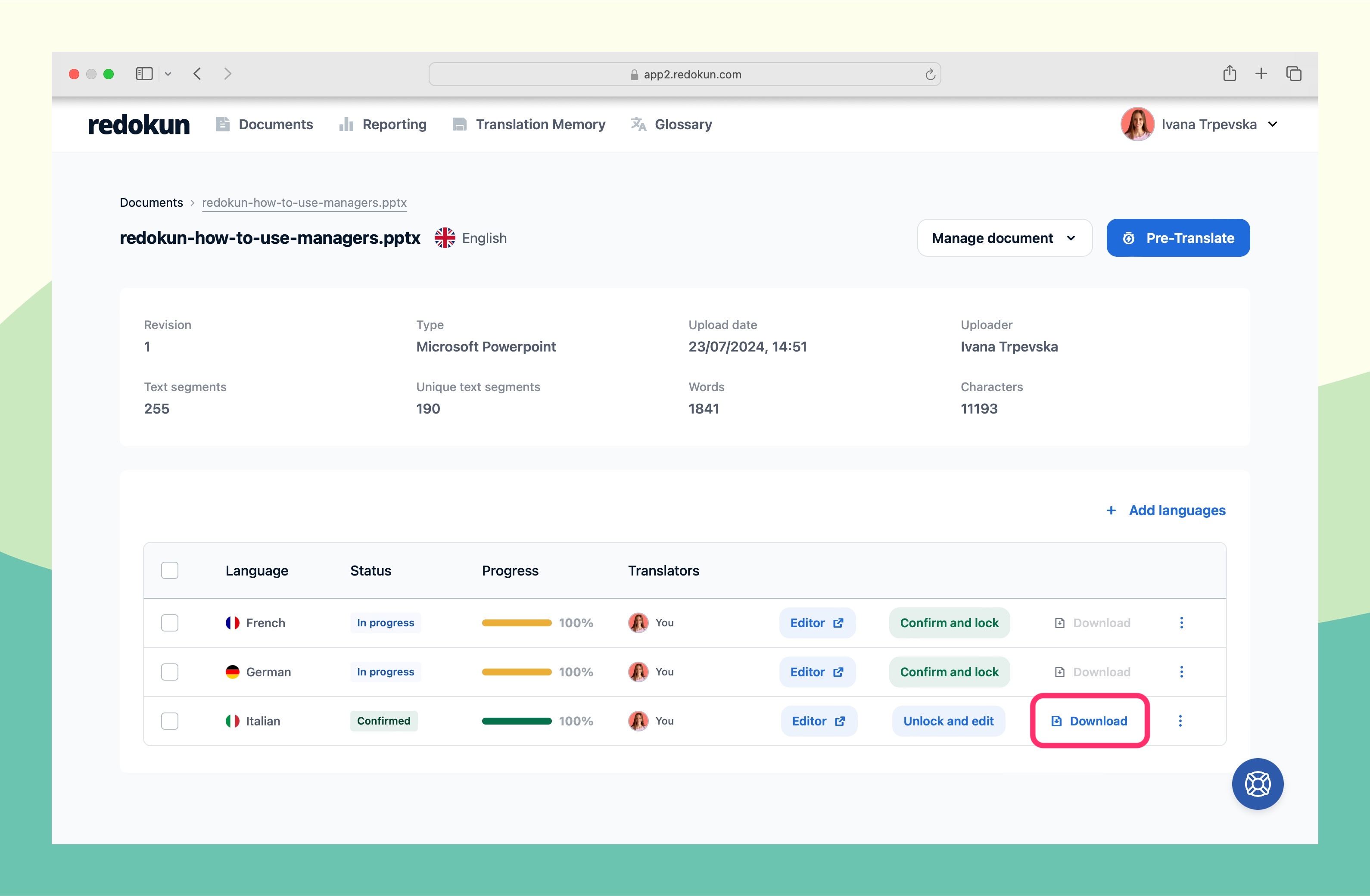
That’s it! Now you have the translated manual at hand, ready to go out to users.
Want to literally see this process in Redokun? Here's an interactive demo that will help you see Redokun in action:
Why Translate Manuals with Redokun
Choosing to translate manuals with Redokun is not only about breaking down the process into four easy steps. Redokun solves all the major problems you might experience as a business striving to localize your manuals and other product documentation.

- Get started translating right away in a simple, clutter-free workspace. With Redokun, your team can start translating right away without needing to spend time figuring out what buttons to push. No need for user licenses to various DTP software or a lengthy onboarding time just to figure out how the software works. Your translators can just focus on the text they need to translate, nothing more.
- Automate your workflow with less time spent on tedious tasks. You don’t need to handle mundane manual tasks anymore — Redokun does those for you. No more endless copy-pasting, reformatting, or manual file import-export mess. That means you can translate efficiently without diverting your time and resources from other essential elements of the translation workflow.
- Have all your translation assets available instantly. You can store, access, and modify the files related to your translation projects on the Redokun cloud storage. No need to look around among dozens of files scattered around different digital locations.
- Ensure translation consistency even when it comes to complex technical terminology. Redokun builds a terminology database for your localization projects automatically. Using translation memories, the system will remember your previous translations and use the accumulated glossary to translate segments in the new file automatically. This feature enhances translation consistency across all documents and language pairs.
- Save money on translation costs. Effectively recycle your past translations with the help of our machine translation features, so you never pay for translating the same word or term twice. On top of that, you can save the money you would otherwise have to invest in designers’ assistance because Redokun keeps your manual layout and visual identity intact. Since you stay in complete control of the translation deliverables, you avoid submission delays.
- Easily manage manual translation into multiple languages. Gather all your translators, editors, and other localization team members in a digital collaboration space. Redokun Web Editor allows you to communicate with specialists working on the manual translation for each language pair. You can leave comments, ask and answer questions, mention people, and stay fully tuned to the ongoing translation progress.
Many of Redokun’s clients highlight the workflow upgrade as the most important gain they’ve experienced compared to working with translation agencies. Here's where you can read how Enbio streamlined the translations of user manuals in 30 different languages, or here's a recap:
Can you still outsource your translations with Redokun?
Yes, you absolutely can.
Sometimes, your translation team doesn’t have language specialists who can translate manuals into a particular target language. In this case, you can turn to outside vendors while still enjoying the advantages of Redokun.
- If the outside translation vendor uses Redokun, invite them to the Web Editor and they can start working on the manual translation right away;
- If your chosen translation vendor is not a Redokun user, keep things simple and productive by only giving them what they need — content for translation:
- Upload your manual.
- Export an exchange file that contains the translatable text for the translator from Redokun.
- Ask the translator to fill up the file with translated text.
- Once the translated file is ready, import it back to Redokun.
- Download your translated manual in the original file format with the layout and design intact.
This way, you only outsource the “language proper” element of your workflow to outside vendors, maintaining control over the whole manual translation project. And you only pay an outside agency for translation itself — all the other costs are effectively eliminated.
Here's a 1-min localization top on why you need to build your in-house translation pipeline:
Manuals Translation: Best Practices
Now you know how to improve your user manual translation workflow with translation software. How else can you enrich the translation process to get quality manuals in other languages? We suggest you consider these three useful manual translation practices.

1. Involve technical experts in the manual translation process
Translation of technical manuals is a challenging task. Manuals can contain industry-specific terminology and bulky sentence structures. Besides, manuals provide precise instructions where every word and its meaning matter.
These aspects can make manual translation problematic even for a skilled translator. It’s not enough to be fluent or native in the target language — technical expertise may also be necessary.
- Hire translators that specialize in the area or industry the manual belongs to. Learn more about the best places to find competent translators here.
- Alternatively, involve a technical expert with native knowledge of the target language. They can review the translation and point to possible errors to fix them promptly. Say, you’re translating a policy manual for an organization. The document may contain company rules, procedures, and guidelines. Make sure to invite a company/industry representative who speaks the target language to check the translation and help you adjust it.
2. Develop an adaptable layout for your manual
Depending on the target language, the density of the translated text can vary a lot. In other words, the text of your translated manual can take up more space than the original.
Take German as an example. When you translate a manual from English into German, the text volume can increase to 35-40%. If your layout is only oriented to the original language, the translated text may not fit. As a result, the whole design of your manual goes awry.
- An easy and effective solution to this problem is to develop a more spacious layout. For example, leave empty space after every logically complete section of the manual so that it could fit a bigger translated text. An extra perk of this approach is that text segmentation and blank spaces make your manual more reader-friendly for users.
3. Send the translated manual drafts for a thorough review
We’ve already mentioned that manual translation needs to be immaculate. After all, user experience, product life, and sometimes even safety are at stake. That’s why translation reviews and language quality assurance (LQA) are key.
- Turn to LQA experts and technical consultants to review your completed manual drafts in the target language. Their feedback will help you fine-tune the translated manual and correct possible inconsistencies.
- Another step you can take is to send your translated manual draft to product testers (along with the product it’s intended for, of course). Have them read it and check whether the manual is accurate and 100% compatible with the product functionality/interface. This way, you’ll know your translated manual is ready to go out to the market.
FAQs
What is a manual translation?
Manual translation is the process of converting text from one language (the source language) to another language (the target language).
What are the benefits of manual translation?
Manual translation (with translation service/ translator) tends to be more accurate and nuanced but all together more expensive and suitable for translating important documents that need to 100% accurate.
What are the three types of manuals?
The three types of manuals are:
- Service manual—helps technicians service, maintain, and repair equipment
- User manual—assists people to use/understand how a device works
- Operational manual—provides guidance for the stuff how to perform their functions currectly and efficiently.
What are manuals used for?
Manuals are used to help people understand better how to use a certain product or service in a seamless way.
Summary
Translating manuals can be a complicated and sometimes joyless task, but it certainly doesn’t have to be.
By using a translation management system to structure your workflow, you can translate manuals faster and more accurately, no matter how complex they are. Redokun helps you enhance your manual translation process with faster translations, automatically recreated designs, and simple project management.
If you want to discover how we can help you create an efficient and comfortable translation workflow, start using Redokun today. Try it free for 14 days!




